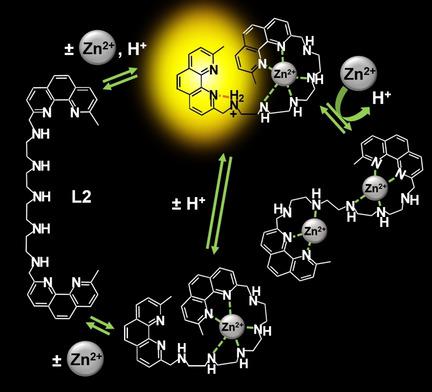当前位置:
X-MOL 学术
›
ChemPlusChem
›
论文详情
Our official English website, www.x-mol.net, welcomes your
feedback! (Note: you will need to create a separate account there.)
Switching on the Fluorescence Emission of Polypyridine Ligands by Simultaneous Zinc(II) Binding and Protonation.
ChemPlusChem ( IF 3.0 ) Pub Date : 2020-04-01 , DOI: 10.1002/cplu.201900752 Luca Conti 1 , Claudia Giorgi 1 , Barbara Valtancoli 1 , Paola Paoli 2 , Patrizia Rossi 2 , Andrea Marchionni 3 , Enrico Faggi 1 , Andrea Bencini 1
ChemPlusChem ( IF 3.0 ) Pub Date : 2020-04-01 , DOI: 10.1002/cplu.201900752 Luca Conti 1 , Claudia Giorgi 1 , Barbara Valtancoli 1 , Paola Paoli 2 , Patrizia Rossi 2 , Andrea Marchionni 3 , Enrico Faggi 1 , Andrea Bencini 1
Affiliation

|
The synthesis and characterization of the two new open‐chain ligands 1,15‐bis‐[6‐(2,2’‐bipyridyl)]‐2,5,8,11,14‐pentaaza‐octadecane (L1) and 1,15‐bis‐[2‐(1,10‐phenanthroline)‐9‐methyl]‐2,5,8,11,14‐pentaazaoctadecane (L2), both featuring a tetraethylenpentaamine chain linking via methylene bridges the 6 and 2 positions of two identical 2,2’‐bipyridyl (bpy) and 9‐methyl‐1,10‐phenanthroline (9‐methyl‐phen) moieties respectively, are reported. Their protonation and binding ability for Cu2+, Zn2+, Cd2+ and Pb2+ have been studied by coupling potentiometric titrations with UV‐vis absorption and fluorescence emission measurements in water. L1 and L2 afford stable mono‐ and dinuclear complexes, in which the metal ion is bound by a single bpy or 9‐methyl‐phen unit and the amine groups on the aliphatic chain. However, L1 displays a greater binding ability for Cu2+ and Zn2+ with respect to L2, the stability constants of the [ML1]2+ complexes being 21.8 (Cu2+) and 19.4 (Zn2+) log units vs 20.34 and 16.8 log. units for the corresponding L2 species. Among all the metal ions tested, only the Zn2+ complex with L2 features an enhanced fluorescence emission at neutral pH, thanks to the simultaneous binding of one Zn2+ ion and H+ ion(s), that inhibits any possible photoinduced electron transfer (PET) process from the amine donors to the excited phen moiety. Binding of a second metal switches off the emission again.
中文翻译:

锌(II)结合和质子化同时打开聚吡啶配体的荧光发射。
两种新的开链配体1,15-双-[[6-(2,2'-联吡啶基)]-2,5,8,11,14-五氮杂十八烷(L1)和1的合成和表征15-双- [2-(1,10-菲咯啉)-9-甲基] -2,5,8,11,14-戊七十八烷(L2),均具有通过亚甲基连接的四亚乙基五胺链,桥的6位和2位报告了两个相同的2,2'-联吡啶(bpy)和9-甲基-1,10-菲咯啉(9-甲基-phen)部分。通过电位滴定与水中的UV-vis吸收和荧光发射测量耦合,研究了它们对Cu 2 +,Zn 2 +,Cd 2+和Pb 2+的质子和结合能力。L1和L2提供稳定的单核和双核络合物,其中金属离子通过单个bpy或9-甲基苯酚单元和脂族链上的胺基键合。然而,相对于L2,L1对Cu 2+和Zn 2+具有更大的结合能力,[M L1 ] 2+配合物的稳定常数为21.8(Cu 2+)和19.4(Zn 2+)对数20.34和16.8对数。对应的L2物种的单位。在所有测试的金属离子中,只有Zn 2+与L2的络合物Zn 2+离子和H +离子同时结合,在中性pH下具有增强的荧光发射特性,从而抑制了任何可能的从胺供体到激发的phen部分的光诱导电子转移(PET)过程。第二种金属的结合会再次关闭发射。
更新日期:2020-04-22
中文翻译:

锌(II)结合和质子化同时打开聚吡啶配体的荧光发射。
两种新的开链配体1,15-双-[[6-(2,2'-联吡啶基)]-2,5,8,11,14-五氮杂十八烷(L1)和1的合成和表征15-双- [2-(1,10-菲咯啉)-9-甲基] -2,5,8,11,14-戊七十八烷(L2),均具有通过亚甲基连接的四亚乙基五胺链,桥的6位和2位报告了两个相同的2,2'-联吡啶(bpy)和9-甲基-1,10-菲咯啉(9-甲基-phen)部分。通过电位滴定与水中的UV-vis吸收和荧光发射测量耦合,研究了它们对Cu 2 +,Zn 2 +,Cd 2+和Pb 2+的质子和结合能力。L1和L2提供稳定的单核和双核络合物,其中金属离子通过单个bpy或9-甲基苯酚单元和脂族链上的胺基键合。然而,相对于L2,L1对Cu 2+和Zn 2+具有更大的结合能力,[M L1 ] 2+配合物的稳定常数为21.8(Cu 2+)和19.4(Zn 2+)对数20.34和16.8对数。对应的L2物种的单位。在所有测试的金属离子中,只有Zn 2+与L2的络合物Zn 2+离子和H +离子同时结合,在中性pH下具有增强的荧光发射特性,从而抑制了任何可能的从胺供体到激发的phen部分的光诱导电子转移(PET)过程。第二种金属的结合会再次关闭发射。











































 京公网安备 11010802027423号
京公网安备 11010802027423号